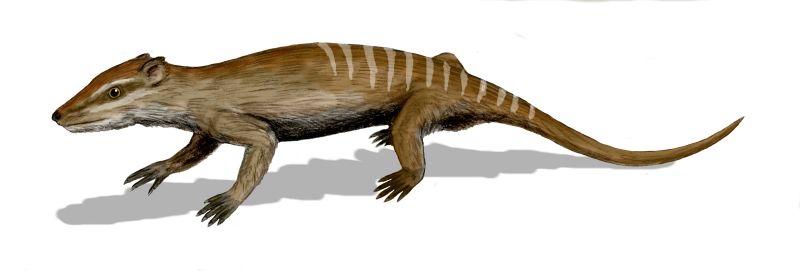- Yanoconodon
image_caption = "Yanoconodon allini"
image_width = 250px
fossil_range =Early Cretaceous
regnum =Animal ia
phylum = Chordata
classis =Mammal ia
ordo = Eutriconodonta
familia =Jeholodentidae
genus = "Yanoconodon"
genus_authority = Chen, Chen, Li & Luo, 2007
species = "Y. allini"
binomial = "Yanoconodon allini"
binomial_authority = Chen, Chen, Li & Luo, 2007"Yanoconodon" is a monotypic genus of extinct early
mammal whose representative species "Yanoconodon allini" lived 125 million years ago during theMesozoic in what is nowChina . It is considered to be atransitional fossil due to the formation of itsmiddle ear , which is a cross between those of modern mammals and their nearest relatives, themammaliaformes . "Yanoconodon" was a Eutriconodont, a group synonymous to the Triconodonts which lived during the time of thedinosaur s. Indeed, some such as "Repenomamus " grew so large that they were able to eat small dinosaurs in some cases. Hu, Y., Meng, J., Wang, Y. & Li, C. (2005). "Large Mesozoic mammals fed on young dinosaurs". Nature. Vol 433,12 January 2005 , Number 7022, pp91-178, doi:10.1038/nature03102. [http://www.newscientist.com/channel/life/dn6874.html See commentary on this article (Retrieved 25/6/2007)] .] In particular, "Yanoconodon" is considered to be closely related to "Jeholodens ".Luo, Z., Chen, P., Li, G., & Chen, M. (2007). "A new eutriconodont mammal and evolutionary development in early mammals". Nature. Vol 446,15 March 2007 , doi:10.1038/nature05627.]"Yanoconodon"'s name is comprised of two elements: 'Yan' is taken from the
Yan Mountains in the north of the Hebei Province near where theholotype of "Yanoconodon" was found in theYixian Formation ; 'Conodon' is an often used as a mammalian taxonomic suffix meaning 'cuspate tooth'. Its species name, "allini," is derived from mammalian researcherEdgar Allin , who was notable for his research on the mammalian middle ear." [http://www.physorg.com/news93110526.html Paleontologists Discover New Mammal from Mesozoic Era] " at [http://www.physorg.com/ www.physorg.com] - Retrieved 25/6/2007.]Description
"Yanoconodon" was a small mammal, barely 5 inches (13 centimetres) long, although at the time of its existence, it was significantly longer than most other animals due to a number of extra
vertebra e the animal possessed. It was lightly-built and fed oninsect s,worm s and otherinvertebrate s. Like other Eutriconodonts, "Yanoconodon" probably hunted at night out of the danger posed by predatory dinosaurs during the day. Like most early mammals, "Yanoconodon" had short, sprawling legs and claws that were most likely used for burrowing underground or digging."Yanoconodon" is the first Mesozoic mammal to be found in China to date. The
holotype of "Yanoconodon" excavated from the fossil-rich Yixian Formation, about 300 kilometres fromBeijing , was brilliantly preserved and allowed scientists to discover what the creature is most notable for, the transitional stage of its middle ear. This is said to be the "Rosetta Stone " in regard to the development of the mammalian middle ear and theevolution of complex anatomic features over time. In addition to this discovery, scientists also discovered the presence of lumbarrib s, a particularly rare feature in mammals today.The closely related Eutriconodont "Jeholodens" lacks these lumbar
rib s and it has been suggested that this morphological difference is due to changes in theHox genes , specifically in the "Hox10" group . In mice a triple mutation knocking out all "Hox10" paralogues leads to the presence of lumbarrib s Deneen M. Wellik and Mario R. Capecchi. (2003). "Hox10 and Hox11 Genes Are Required to Globally Pattern the Mammalian Skeleton". Science, Vol. 301,18 July 2003 , no. 5631, pp. 363 - 367, DOI: 10.1126/science.1085672.] supporting the theory that these genes have evolved the ability to repress the ancestral Lumbar morphology seen in the Eutriconodonts.References
External links
* [http://www.smm.org/buzz/image/yanoconodon_allini Artist's impression of "Y. allini"] .
Wikimedia Foundation. 2010.

